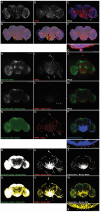Optimization and Technical Considerations for the Dye-Exclusion Protocol Used to Assess Blood-Brain Barrier Integrity in Adult Drosophila melanogaster
- PMID: 36768206
- PMCID: PMC9916281
- DOI: 10.3390/ijms24031886
Optimization and Technical Considerations for the Dye-Exclusion Protocol Used to Assess Blood-Brain Barrier Integrity in Adult Drosophila melanogaster
Abstract
The blood-brain barrier (BBB) is a multicellular construct that regulates the diffusion and transport of metabolites, ions, toxins, and inflammatory mediators into and out of the central nervous system (CNS). Its integrity is essential for proper brain physiology, and its breakdown has been shown to contribute to neurological dysfunction. The BBB in vertebrates exists primarily through the coordination between endothelial cells, pericytes, and astrocytes, while invertebrates, which lack a vascularized circulatory system, typically have a barrier composed of glial cells that separate the CNS from humoral fluids. Notably, the invertebrate barrier is molecularly and functionally analogous to the vertebrate BBB, and the fruit fly, Drosophila melanogaster, is increasingly recognized as a useful model system in which to investigate barrier function. The most widely used technique to assess barrier function in the fly is the dye-exclusion assay, which involves monitoring the infiltration of a fluorescent-coupled dextran into the brain. In this study, we explore analytical and technical considerations of this procedure that yield a more reliable assessment of barrier function, and we validate our findings using a traumatic injury model. Together, we have identified parameters that optimize the dye-exclusion assay and provide an alternative framework for future studies examining barrier function in Drosophila.
Keywords: Drosophila melanogaster; barrier integrity; blood–brain barrier; dye-exclusion assay; traumatic injury.
Conflict of interest statement
The authors declare no conflict of interest.
Figures



References
MeSH terms
Grants and funding
LinkOut - more resources
Full Text Sources
Molecular Biology Databases

